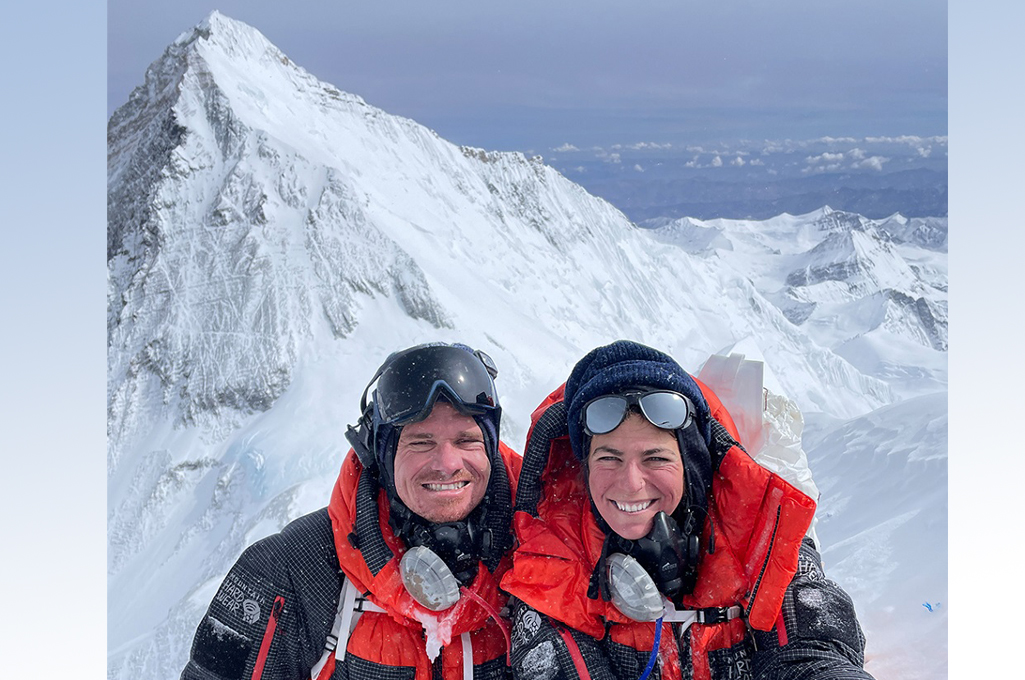By Sydney Severn
After a rather dangerous year in the peaks and plummets of the tallest mountain on the planet, Deaf Maryland locals Shayna Unger and Scott Lehmann summited Mount Everest on May 22nd of this year.
After the Nepali Supreme Court overturned its (albeit, ableist) ban on disabled people climbing Everest—claiming it would create more work for Sherpa guides on the mountain to accommodate people with disabilities—the couple made history as the first Deaf Americans to do so (the third and fourth on record). Unger became the first woman. “This has ignited [our] passion for making the outdoors more accessible to the Deaf and hard-of-hearing community,” the duo commented on their website.
Lehmann began to pursue his love for climbing in 2012, after taking a cross-country trip post-graduation, and attempted to summit Mt. Rainier. Due to a lack of accessible resources, Lehmann was met with significant communication barriers, limited Deaf and hard-of-hearing representation and restricted access to mountaineering education and opportunities in his attempt to scale Rainier. He was, thus, unable to complete the climb.
He signed up for a climbing course but was responsible for hiring and funding an interpreter, additionally needing to do so for every expedition he would take. In defiance of the unjust obligation, Lehmann tried teaching himself through YouTube videos, but, yet again, encountered an inaccessible language barrier. As a successful last resort, he learned to climb through trial and error, observing other climbers and asking questions as best he could. “I’d often show up on the mountain and ask anyone who would answer my questions [by writing them down on notepads],” Lehmann told People.
He then taught Unger, his girlfriend, revealing, “I wanted to save her the embarrassment of having to ask random strangers on the mountain…it was really amazing how quickly she learned because she had direct access to the information from me.”
They shortly summited Mt. Kilimanjaro in 2015, working up to Mt. Denali in 2021. “The day after we got off Denali, we looked at each other and said, ‘let’s go for it’ [‘it’ being Everest].”
The team wrote on social media, “Statistically…one in eight Americans are either Deaf or hard-of-hearing, yet there has been only one Deaf person who has summited Everest. It makes us wonder if this space has ever been accessible for people like us. When will the world be open to our way of communicating and see it as equal? We say the time is now.”
Soon enough, Unger and Lehmann met with a few Sherpa guides and developed a functional communication system, bridging the gap between American Sign Language and hand signals. After about three weeks of working together, plus funding and sponsorship, their climbing party was good to go. They arrived at Everest Base Camp on May 2nd, briefly waiting for safer weather conditions to permit their ascent.
“There’s a lot of different barriers we had to go through to get to Everest,” Unger told CNN. “So, when we reached the top, we felt like we overcame the odds…we were really proud of ourselves.”
On their way up they met and befriended Muhammad Hawari Hashim, only the second Deaf person to reach the top, who would summit many days prior on May 18th. Unfortunately, he hasn’t been seen since.
Lehmann states, “It hasn’t been an easy journey because there are no footsteps for us to follow, so we’re kind of trailing and are creating new paths.”
And, they did. Through the wind, snow, below-freezing conditions and unreliable hours of darkness, Unger and Lehmann made it to the top.
Their accomplishment pushes them more than halfway to their mountaineering goal: completing the Seven Summits (to climb the highest mountains on each continent). They will be the first Deaf climbers to do so, and they explore this group objective in their online project, Seeing Beyond: Seven Summits.
Having already achieved Kilimanjaro, Denali, Aconcagua and now Everest, Unger and Lehmann have yet to summit Elbrus, Vinson and Puncak Jaya. “With the right attitude and the right adjustments, [the outdoors] is available for Deaf and hard-of-hearing people,” Lehmann says to CNN. “It’s available for people with disabilities.”
Unger and Lehmann now visit Deaf schools across the country to give presentations about their journeys and experiences, also giving glimpses of their gear. “We just notice how much the kids are so excited and inspired, but they’re also like, you know, awestruck because they’ve never seen what we’re doing in Deaf spaces,” Unger said. “We want this to have a ripple effect.”
The couple opens the discussion that just because you have not seen something doesn’t mean it does not or cannot exist.
Though they are not spokespeople for the Deaf and hard-of-hearing or disabled communities as a whole, the climbing team admits to noticing a shift in the non-disabled population, being more accommodating and willing to work with them. They advocate for diversity and normalize it, connecting the Deaf and hard-of-hearing community with their climbing adventures to prove it’s open to everyone. Just as destigmatizing disability is the answer; advocating for accessibility is too.
Lehmann says, “It’s not just about reaching the summit…it’s the whole experience, sharing what we’ve learned with our community,” highlighting the normalcy of their accomplishment and that anyone can do it.
Unger alludes to their next climb in an interview: “We’re still processing Everest. But for sure, next will be one of the three Seven Summits. Which one, we’re not sure…”




